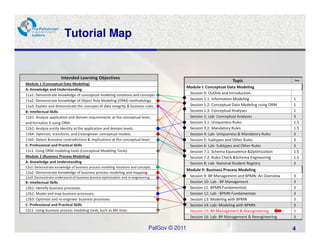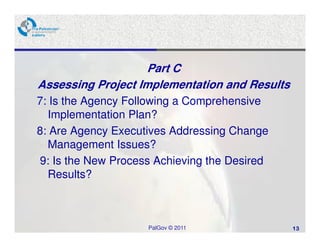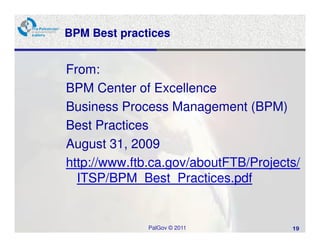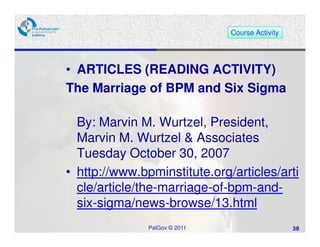Pal gov.tutorial1.session15 16
- 1. ط ا رو ا و ا أ د The Palestinian eGovernment Academy www.egovacademy.ps Tutorial 1:Process and Data Modeling Session 15 -16 Business Process Management (best practices and BP Re-engineering) Dr. Mahmoud H. M. Saheb Reviewed by Prof. Marco Ronchetti, Trento University, Italy PalGov © 2011 1
- 2. About This tutorial is part of the PalGov project, funded by the TEMPUS IV program of the Commission of the European Communities, grant agreement 511159-TEMPUS-1- 2010-1-PS-TEMPUS-JPHES. The project website: www.egovacademy.ps Project Consortium: Birzeit University, Palestine University of Trento, Italy (Coordinator ) Palestine Polytechnic University, Palestine Vrije Universiteit Brussel, Belgium Palestine Technical University, Palestine Université de Savoie, France Ministry of Telecom and IT, Palestine University of Namur, Belgium Ministry of Interior, Palestine TrueTrust, UK Ministry of Local Government, Palestine Coordinator: Dr. Mustafa Jarrar Birzeit University, P.O.Box 14- Birzeit, Palestine Telfax:+972 2 2982935 [email protected] © 2011 2
- 3. © Copyright Notes Everyone is encouraged to use this material, or part of it, but should properly cite the project (logo and website), and the author of that part. No part of this tutorial may be reproduced or modified in any form or by any means, without prior written permission from the project, who have the full copyrights on the material. Attribution-NonCommercial-ShareAlike CC-BY-NC-SA This license lets others remix, tweak, and build upon your work non- commercially, as long as they credit you and license their new creations under the identical terms. PalGov © 2011 3
- 4. Tutorial Map Intended Learning Objectives Topic Time Module 1 (Conceptual Date Modeling) Module I: Conceptual Data Modeling A: Knowledge and Understanding 11a1: Demonstrate knowledge of conceptual modeling notations and concepts Session 0: Outline and Introduction 11a2: Demonstrate knowledge of Object Role Modeling (ORM) methodology. Session 1.1: Information Modeling 1 11a3: Explain and demonstrate the concepts of data integrity & business rules Session 1.2: Conceptual Data Modeling using ORM 1 B: Intellectual Skills Session 1.3: Conceptual Analyses 1 11b1: Analyze application and domain requirements at the conceptual level, Session 2: Lab- Conceptual Analyses 3 and formalize it using ORM. Session 3.1: Uniqueness Rules 1.5 11b2: Analyze entity identity at the application and domain levels. Session 3.2: Mandatory Rules 1.5 11b4: Optimize, transform, and (re)engineer conceptual models. Session 4: Lab- Uniqueness & Mandatory Rules 3 11b5: Detect &resolve contradictions & implications at the conceptual level. Session 5: Subtypes and Other Rules 3 C: Professional and Practical Skills Session 6: Lab- Subtypes and Other Rules 3 11c1: Using ORM modeling tools (Conceptual Modeling Tools). Session 7.1: Schema Equivalence &Optimization 1.5 Module 2 (Business Process Modeling) Session 7.2: Rules Check &Schema Engineering 1.5 A: Knowledge and Understanding Session 8: Lab- National Student Registry 3 12a1: Demonstrate knowledge of business process modeling notations and concepts. Module II: Business Process Modeling 12a2: Demonstrate knowledge of business process modeling and mapping. 12a3: Demonstrate understand of business process optimization and re-engineering. Session 9: BP Management and BPMN: An Overview 3 B: Intellectual Skills Session 10: Lab - BP Management 3 12b1: Identify business processes. Session 11: BPMN Fundamentals 3 12b2: Model and map business processes. Session 12: Lab - BPMN Fundamentals 3 12b3: Optimize and re-engineer business processes. Session 13: Modeling with BPMN 3 C: Professional and Practical Skills Session 14: Lab- Modeling with BPMN 3 12c1: Using business process modeling tools, such as MS Visio. Session 15: BP Management & Reengineering 3 Session 16: Lab- BP Management & Reengineering 3 PalGov © 2011 4
- 5. Business Process Management Session ILOs After completing this session students will be able to: 1. Demonstrate knowledge of BP management, re-engineering 2. Optimize and re-engineer business process. 3. Use BP modeling tools. PalGov © 2011 5
- 6. Outline • BP Management – BP Re-engineering – Best practices – Lean six sigma and BPM (read) • Summary PalGov © 2011 6
- 7. What is BPR Reengineering is the fundamental rethinking and redesign of business processes to achieve dramatic improvements in critical, contemporary measures of performance, such as cost, quality, service and speed. (Hammer & Champy, 1993) Change is a “struggle”; BPR is a “war” (Jessica keyes) PalGov © 2011 7
- 8. BPR Versus Process Simplification Process Simplification Process Reengineering Incremental Change Radical Transformation Process-Led Vision-Led Assume Attitudes & Behaviours Change Attitudes & Behaviours Management-Led Director-Led Limited Number of Initiatives Various Simultaneous Projects (Coulson-Thomas, 1992) PalGov © 2011 8
- 9. BPR Versus Continuous Improvement Continuous Improvement Process Reengineering Incremental Change Radical Transformation People Focus People & Technology Focus Low Investment High Investment Improve Existing Rebuild Work Unit Driven Champion Driven PalGov © 2011 9
- 10. BPR Characteristics Systems Philosophy Global Perspective on Business Processes Radical Improvement Integrated Change People Centred Focus on End-Customers Process-Based PalGov © 2011 10
- 11. Framework For Assessing Reengineering Part A Assessing the Organization’s Decision to Pursue Reengineering 1: Has the Agency Reassessed Its Mission and Strategic Goals? 2: Has the Agency Identified Performance Problems and Set Improvement Goals? 3: Should the Agency Engage in reengineering? PalGov © 2011 11
- 12. Part B Assessing the New Process' Development 4: Is the Reengineering Project Appropriately Managed? 5: Has the Project Team Analyzed the Target Process and Developed Feasible Alternatives? 6: Has the Project Team Completed a Sound Business Case for Implementing the New Process? PalGov © 2011 12
- 13. Part C Assessing Project Implementation and Results 7: Is the Agency Following a Comprehensive Implementation Plan? 8: Are Agency Executives Addressing Change Management Issues? 9: Is the New Process Achieving the Desired Results? PalGov © 2011 13
- 14. BPM Best practices From: BPM Center of Excellence Business Process Management (BPM) Best Practices August 31, 2009 http://www.ftb.ca.gov/aboutFTB/Projects/ ITSP/BPM_Best_Practices.pdf PalGov © 2011 14
- 15. BPM Best practices From: BPM Center of Excellence Business Process Management (BPM) Best Practices August 31, 2009 http://www.ftb.ca.gov/aboutFTB/Projects/ ITSP/BPM_Best_Practices.pdf PalGov © 2011 15
- 16. BPM Best practices From: BPM Center of Excellence Business Process Management (BPM) Best Practices August 31, 2009 http://www.ftb.ca.gov/aboutFTB/Projects/ ITSP/BPM_Best_Practices.pdf PalGov © 2011 16
- 17. BPM Best practices From: BPM Center of Excellence Business Process Management (BPM) Best Practices August 31, 2009 http://www.ftb.ca.gov/aboutFTB/Projects/ ITSP/BPM_Best_Practices.pdf PalGov © 2011 17
- 18. BPM Best practices From: BPM Center of Excellence Business Process Management (BPM) Best Practices August 31, 2009 http://www.ftb.ca.gov/aboutFTB/Projects/ ITSP/BPM_Best_Practices.pdf PalGov © 2011 18
- 19. BPM Best practices From: BPM Center of Excellence Business Process Management (BPM) Best Practices August 31, 2009 http://www.ftb.ca.gov/aboutFTB/Projects/ ITSP/BPM_Best_Practices.pdf PalGov © 2011 19
- 20. Best Practices List 1. A Strong Partnership With IT 2. Create a BPM Enterprise Implementation Team 3. Use Tools Based on Industry Standards 4. Select a Process Methodology 5. Secure Executive Sponsorship 6. Select the Right Project 7. Lead With the Right People 8. Manage Expectations 9. Benchmark the Current Process 10. Define Key Performance Indicators (KPIs) 11. Foster Cultural Change 12. Focus on Your Customer 13. Focus on Your Process Workers 14. Take a Board View of Training 15. Profit from Experience 16. Develop a Robust Governance Framework PalGov © 2011 20
- 21. 1- A strong Partnership with IT • IT is an enabler not a leader of a BPM effort – It is business. • A BPM project is not an IT project but a business management modification that can be enhanced by the use of technology. • A strong partnership between business and IT will ensure a smoother project. e-Government Lifelong 21 Learning
- 22. 2- Create a BPM Enterprise Implementation Team (EIT) Create a BPM EIT that is: • cross-functional organization • comprised of committed To: develop and implement a Pilot project enabling the delivery of a quick solution to an immediate problem and proves the overall approach. PalGov © 2011 22
- 23. 3- Use Tools Based on Industry Standards Utilizing tools based on industry standards allows for the following benefits: • Decreased implementation and maintenance costs • Increased ability to consolidate • Increased availability of talented resources • Decreased education and training costs • Simplification of modifications • Increased flexibility to migrate to another technology PalGov © 2011 23
- 24. 4- Select a Process Methodology It is the methodology not the technology that provide the success. BPM is primarily a management discipline that requires a guiding methodology or set of methodologies. It provides common language, and it must cover the whole process life cycle. PalGov © 2011 24
- 25. 5- Secure Executive Sponsorship As all projects executive sponsorship is mandatory for a BPM effort to be successful. PalGov © 2011 25
- 26. 6- Select the Right Project Selecting the first project is critical. The following are characteristics of a Right BPM Project: • Small /manageable • One business process • Large impact on a small number of people • Measurable • Significant impact • Visible • Visible benefit • Good ROI • Clear scope • Extendable • Connected to a strategic or operational objective • Well documented with knowledgeable subject matters PalGov © 2011 26
- 27. Select the Right Project Cont. Projects with the following usually offer strong potential for initial BPM projects: • Processes that are manual, paper-intense, ad hoc, inconsistent, etc. • Processes that need to be integrated with several different systems • Processes with immediate & recognizable pain points • Processes that map directly to a key organizational objective • Processes that are critical to the business • Processes with confirmed executive sponsorship PalGov © 2011 27
- 28. 7- Lead With the Right People The following are a few of the characteristics of BPM leaders: • Thinking differently • Understand both the business and the technology • People respected by their peers • Embody best practices. • Focused on business first then IT • Communicate/translate effectively Patient • Maintain effective change management skill PalGov © 2011 28
- 29. 8- Manage Expectations • Manage expectations and understand why people are involved and their “personal wins” • Success criteria to successful MBP should be agreed on and documented PalGov © 2011 29
- 30. 9- Benchmark the Current Process Begin the BPM process by selecting a few metrics that are of high value in the short term then progress to long term measures. Metrics are classified in three ways: customer, financial, and operational. To accurately define your baseline: • Fully document the current processes o Identify key activities o Who does it - Map out individual roles o When is it done o How often is it done o How long does it take to do it o Define flows of work • Interview key stakeholders and process participants • Identify process origins and rationale behind how things are done • Identify the “gaps” between activities, people, and systems - as these are areas of opportunity for BPM PalGov © 2011 30
- 31. 10- Define Key Performance Indicators (KPIs) KPI: is a measure of performance. • Don’t start without KPI. • Identify BPM Center of Excellence specific metrics that are measurable and can be mapped to business goals and objectives. • Developing a ROI model will assist in the analysis of the success of BPM. PalGov © 2011 31
- 32. 11- Foster Cultural Change • Different cultures need different approaches • People will need to be encouraged to come with ideas • Management will need to lead by example PalGov © 2011 32
- 33. 12- Focus on Your Customer • Again, it is not using technology what will make the change. It is the management and the customer satisfaction. • BPM has been more successful than previous ‘process oriented’ approaches because it blends technology with management best practice PalGov © 2011 33
- 34. 13- Focus on Your Process Workers • Shield the business users from the infrastructure. • Use technology to simplify processes. • Use friendly graphical user interfaces. • Listen to the business users. PalGov © 2011 34
- 35. 14- Take a Broad View of Training Training is critical to success with Training Methodology Tools PalGov © 2011 35
- 36. 15- Profit from Experience Document you experience, this will be use to develop a methodology for repeatable BPM delivery. A methodology is a series of steps. PalGov © 2011 36
- 37. 16- Develop a Robust Governance Framework Governance Framework are: rules, policies and communication mechanisms that control how people make decisions and initiate change. For success this framework should be built. PalGov © 2011 37
- 38. Course Activity • ARTICLES (READING ACTIVITY) The Marriage of BPM and Six Sigma By: Marvin M. Wurtzel, President, Marvin M. Wurtzel & Associates Tuesday October 30, 2007 • http://www.bpminstitute.org/articles/arti cle/article/the-marriage-of-bpm-and- six-sigma/news-browse/13.html PalGov © 2011 38
- 39. Session 16: Lab Activity 1- use Bonita to define data and forms. 2- Assignment 4: Use: Business Process Re-engineering Assessment Guide, United States General Accounting Office, May 1997. To develop guide lines for BP Re-engineering, then use these guide lines for re-engineer one of your processes in your organization. 39
- 40. Summary • In this session we have discussed: – BPR – BPM Best practices PalGov © 2011 40
- 41. References 1. BPM Center of Excellence, Business Process Management (BPM), Best Practices, August 31, 2009 http://www.ftb.ca.gov/aboutFTB/Projects/ITSP/BPM_Best_Practices.pdf . 2. Business Process Re-engineering Assessment Guide, United States General Accounting Office, May 1997. http://www.gao.gov/special.pubs/bprag/bprag.pdf 3. How to use BPMN for modeling Business processes, Alexander Samarin, http://www.slideshare.net/samarin/how-to-use-bpmn-for-modelling-business- processes PalGov © 2011 41
- 42. Thanks Dr. Mahmoud H. Saheb PalGov © 2011 42










































